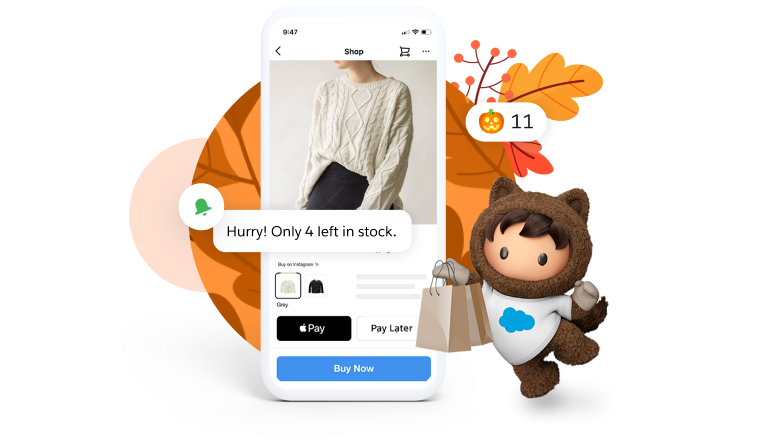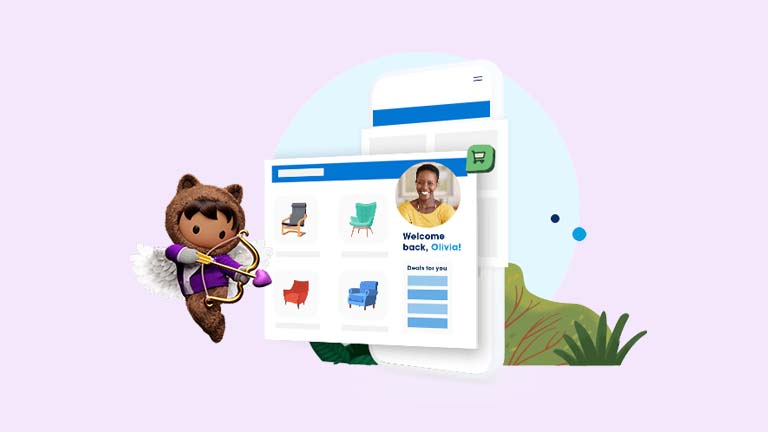Chapter 2: Remove friction from complex shopping journeys.
Multi-channel shoppers expect seamless experiences, no matter how they interact with your brand.


– State of the Connected Customer, Fifth Edition, Salesforce, 2022
Create real-time inventory visibility and fulfillment flexibility.
As many who have shopped on Black Friday can attest, it’s disappointing to find an empty shelf after waiting hours in line. Now imagine how excited you’d be if there was a store associate standing near those empty shelves, locating products and taking orders for home delivery. Leaders are connecting back-end systems – using advancements in composable APIs – so store (and online) associates can view real-time inventory and fulfill orders across the enterprise. With the right order management system, you can stay on top of orders from the point of purchase through fulfillment, no matter how your customers choose to shop.
This is especially critical during this holiday shopping season as retailers face high demand and (likely) product shortages. A real-time view of warehouse and in-store inventory ensures you can sell across physical and digital channels without having to worry about delivering a post-purchase out-of-stock notice. You can also use order management to enable flexible fulfillment options like buy online, pick up in store (BOPIS), streamline returns and exchanges, and ensure customers can access their order history and delivery journey.
Keep online shopping experiences fresh with headless architecture.
For customers, holiday shopping excitement is all about finding amazing deals at flash sales, blowout events, and during huge promotions. Conceiving and delivering those memorable moments is challenging enough for retailers. But at the same time companies are working to attract shoppers’ attention, changes in inventory, customer demand, and delivery capability are accelerating behind the scenes. Retailers know their online experiences need to keep up with what’s happening in real time. The challenge? Using traditional site architecture, keeping digital channels fresh can take many days and resources, a critical disadvantage during peak shopping season.
Headless commerce enables retailers to make changes in hours instead of days. Imagine a retailer that’s just received a shipment of cold-brew coffee makers. It’s been a top seller all year, stock is low, and the new shipment wasn’t expected until January. At a headless company, the business unit could update every virtual experience from the website to the metaverse quickly and at one time. This is likely why companies with headless commerce report excelling at digital commerce at greater rates (55%) than companies without headless architecture.
Add new purchase and payment options.
Optimise mobile commerce experiences.
Customers are increasingly using mobile devices to shop for holiday gifts. Not only did mobile devices account for 60% of order share in Q4 2021, it comprised 72.9% of total ecommerce spend. Make it easy for your customers to shop from their phones with simple designs that load fast, feature large “buy now” buttons, and offer seamless checkout experiences.
Mobile marketing programs that communicate personalised information through push notifications or text messages are another place retailers should focus. That’s incredibly important at the holidays as shoppers eagerly await restock notices, special promotions, and delivery confirmations.
Social selling innovations bring store experiences home.
Social shopping, alongside innovations like live streaming, are changing the ecommerce landscape. And the data suggests that brands are just getting started: Social commerce is predicted to grow three times faster than traditional ecommerce over the next four years.
Consider a shopper who thinks he’s found the perfect gift on Instagram. It’s hard to tell from looking at a flat image if the product is exactly right. But when he can watch a live stream with a store associate, he can ask questions and potentially avoid buying an unwanted item — a huge win for retailers as they face a 20.8% online returns rate.
Next: Chapter 3: Create lifelong customers with connected and consistent service.
- Empower customers with self-service
- Connect voice, digital, and in-person service channels
- Cross-train associates for service and sales
More Resources

Acquire and Engage Loyal Customers

Extra “At your service!” anytime, anywhere.







